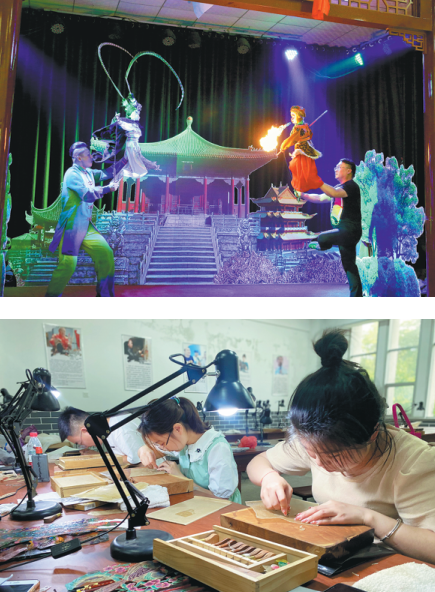Ancient puppet arts kept alive at city's museum
Updated: 2023-07-14

From top: Manipulating puppets to spit fire is one of the unique skills that help Xiaoyi's art form stand out from others in the rest of the country. Students learn to make puppet figures at a studio in Xiaoyi. [Photo provided to China Daily]
At the heart of a bustling business district in the Shanxi city of Xiaoyi is an ancient courtyard surrounded by modern office, shopping and residential buildings. This is China's first museum for shadow puppetry and other forms of puppet arts.
The museum, built in the 1980s and covering a land area of about 10,000 square meters, exhibits shadow puppet figures, marionettes, scripts and other accessories collected from Xiaoyi and across the rest of the country. There are also photos and videos of shadow play shows and a history of the arts.
Shadow puppetry, also called shadow play, is one of the historical folk arts in China. It is a form of storytelling that uses puppet figures against an illuminated backdrop to create the illusion of moving images.
However, the art, which used to be a main form of entertainment in rural China, is in a process of decline. Nowadays, there are more options for entertainment. The art faces the risk of extinction in many parts of the country, with shadow play troupes disbanded, talented artists growing old or even dying and many scripts becoming lost.
Fortunately, the art is relatively well preserved in Xiaoyi and is still a part of local life, according to Zhu Wen, dean of the museum.
He added that Xiaoyi's shadow puppetry has its origins in the Warring States Period (475-221 BC). It became mature in the Song Dynasty (960-1279) and reached its peak in the Ming (1368-1644) and Qing (1644-1911) dynasties.
"Xiaoyi's shadow puppetry has many distinct features compared with those in the rest of the country," Zhu said.
"Puppeteers in Xiaoyi are able to change the facial expressions of puppet figures and carry out complicated movements, such as dancing with long sleeves flapping, practicing calligraphy and even spitting fire."
The dean said one of the missions of the museum is to raise enthusiasm among the public for the art and help to pass it down to future generations.
For these purposes, the museum has strengthened cooperation with local artists, staged shows and organized events to train youngsters.
During the recent May Day holiday, for instance, renowned puppet maker Hu Fawei opened a workshop at the museum, displaying his skills on-site. Next to his workshop were shows staged by master puppeteer Guo Erbao.
In addition to the museum, there are many artists and organizations engaged in the protection and inheritance of the art in Xiaoyi.
Renowned puppetry artist Hou Jianchuan, for instance, has established a studio for the disabled, helping them to master the skill.
He has led his special troupe to perform in Xiaoyi and throughout the rest of Shanxi, helping the members earn a livelihood.
"The best way to preserve a traditional art is to make it a source of income for people, especially for the underprivileged," Hou said.
Xiaoyi Puppetry Troupe, the leading troupe in the city, has an even greater ambition to bring the art to the world.
It recently staged a show at an evening gala for the 14th Annual Meeting of the New Champions, or the Summer Davos Forum, held in Tianjin in late June. It won praise from the forum's participants, according to Liu Yaxing, head of the troupe.
Chen Lihong contributed to this story.



